Remembrance – Ernest Codling
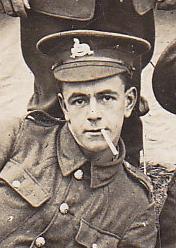
Today we remember Bourne man Ernest Codling who was killed in action on this day, 8th June 1917, serving with the 6th Battalion Lincolnshire Regiment during the second day of the Battle of Messines Ridge.
Ernest Codling was born on the 28th August 1896 at 51 King Street Lincoln to John Codling, a railway porter from Lincoln and his wife Mary Elizabeth Cobb. John and Mary were married in Lincoln in 1892.
John and Mary had 8 children in total, unfortunately they had lost 3 of them before 1911.
- Albert Codling, 1893, Lincoln
- Gertrude Mary Codling, 1894, Lincoln
- Ernest Codling, 1896, Lincoln
- John William Codling, 1906, Lincoln
- Doris May Codling, 1910, Lincoln
The three children they lost were between census returns and so their names are not currently known.
In 1901 John, Mary and their three children were living at 37 Queen Street Lincoln. The next year Ernest started St Peter at Gowts infants school on the 11th June 1902 where he remained until 22nd August 1905. The National Schools admission register indicates that when leaving St Peter at Gowts Ernest went on to attend the newly re-organised St Andrews school in St Andrews Street Lincoln.
By 1911 Ernest had moved from home and was living with his uncle, William Marshall Codling, at Watering Dyke Farm, Grange-de-Lings near Nettleham, Lincoln. Here he worked as a farm servant and the census lists his job as “odd duties”.
Ernest later moved back to live with his parents at 1 Naan Cottages, Grey Street, Lincoln and started working as a warehouseman.
During the war years the family moved to Bourne and settled there. Whilst in Bourne the family received the sad new that Ernest’s oldest brother, Albert, who had joined the Lincolnshire Regiment before the war, had been killed in May 1915 in the area around Ypres.
Ernest enlisted into the army at Lincoln on the 8th December 1914.
Ernest’s full service records, like that of 60% of the men from WW1 cannot be found. It is likely that they are part of the records destroyed in a London warehouse fire during the Blitz. The following story of Ernest’s war has been pieced together with as much accuracy as possible for other surviving records.
The medal rolls also show that Ernest has three separate regimental numbers tied into different Battalions of the Lincolnshire regiment. It is likely that on enlistment he was assigned to the 4th Battalion (3442) to start training. The associated medal card shows that he was not eligible for the 1914/15 Star and certainly no 1914/15 star medal roll has been found which would support this fact. You would assume that he did not serve abroad before the end of 1915 however other documents may dispute this fact. Until recent documents were found with regards to a wounded list it was always thought that Ernest did not serve abroad until 1916.
The 4th Battalion had been mobilised for war and landed at Harvre on the 1st March 1915 as part of the 138th Brigade of the 46th Division. There is no documentary evidence to say that Ernest was amongst this first mobilisation and if he had started training immediately on enlistment it could be possible but without the proof we will not describe the exact movements of the 4th Battalion at this point.
Albert Codling, Ernest’s brother was also serving with the 4th Battalion and certainly was part of the first mobilisation in March 1915. Albert had been killed on the 13th May in fighting around Lindenhoek and it is possible that Ernest was already in the Battalion fighting at the same time.
During 1915 the Battalion would also be involved in the first liquid fire attack at Hooge.
We next find that on the Army’s Casualty List issued by the war office on the 28th October 1915, Private Ernest Codling 3442, 4th Battalion, serving in France and Flanders was listed as “Wounded”. In our experience these lists could be as much as 4 weeks and in extreme cases 6 weeks behind real life and therefore the exact date of being wounded and the nature of this remains unknown for now.
During September the Battalion had been at Bellewarde just outside Ypres but during the first week of October they were moved to Busnettes, North-West of Bethune where they underwent training. On the 8th the officers were taken to Vermelles where they inspected the trenches and got a first look at the Hohenzollern Redoubt. The rest of the men would see a model of the Redout 2 days later as part of their training.
On the 13th October the Hohenzollern Redoubt was taken, the 4th Lincs in support of the 5th Lincs and 4th Leics but at great cost to the Battalion with 10 officers and 385 other ranks falling as casualties.
It is not known if it was this action where Ernest was wounded or if it was during the time in late September near Ypres.
After a man had recovered from his injuries, if bad enough he would be sent back for convalescence rather than his old Battalion until a time when he was classed as medically fit re-join a Battalion. In many cases the attrition rate and the rate of replacements was so great that it was most likely that they would be placed into a Battalion that was in most need of experienced men. This may be the trigger for Ernest being posted to the 5th Battalion Lincolnshire regiment (20047) or his later posting to the 6th Battalion (40635), in both cases we have no documentary proof of the dates.
There are similar 200xx regimental numbering ranges being used by men joining the Supernumery Companies of the 5th Lincs around September 1915 (reserve companies on home service), and so we suspect that Ernest Joined a company of the 5th Lincs when he was fit enough and this may have been at one of the base camps or back in England. It is possible that he was then posted to the 6th Battalion when he regained A1 fitness. This is a possibility based on other records for men around a similar time but without any documentary proof plus we have no further wounded lists that support a second injury or posting to the 6th battalion.
We do know that when he was killed, Ernest Codling was with the 6th Battalion and so we can only look at his movements during his last month. Unfortunately, the diaries for the 6th Battalion from this period are largely unreadable and so a ful transcription may take a long while and a lot of patience.
The following extract is from “The History of the 6th Service Battalion Lincolnshire Regiment” by Colonel F.G. Spring, and is the best source of information for this period (May 1917). For clarity the 6th Battalion were Part of the 33rd Infantry Brigade of the 11th Division, 2nd Army.
“The maintenance of pressure on the Arras front, which kept the enemy constantly on the alert, enabled final preparations to be made for the opening of the Flanders offensive, which was to begin with the Battle of Messines.
The actual front selected for this operation extended between nine and ten miles from a point opposite St. Yves to Mount Sorrel. The objective of the attack was a group of hills known as the Messines-Wytschaete Ridge, which lies about midway between Armentières and Ypres. Messines itself is situated on the southern spur of the ridge which commands a wide view of the valley of the Lys and enfiladed the British lines to the south. North-west of Messines, Wytschaete, situated at the point of the salient and on the highest part of the ridge, commanded a view of almost the entire town of Ypres and all the old British positions in the Ypres Salient.
A special feature in the operations due to take place on the 7th of June was one original in warfare – the explosion of nineteen deep mines at the moment of assault. No such mining feat had ever before been attempted. In the construction of these mines, eight thousand yards of gallery had been driven and over one million pounds of explosives used.
Nine divisions were to take part in the actual assault, and three were in support, among which was the 11th Division who latter lay opposite Wytschaete, and in rear of the 16th Division at the centre of the attack.
Having left Albert (Somme) on the night of 17th/18th of May, the 6th Lincolns detrained at Caëstre and marched to Le Thieushouck where they were billeted. The first three days at Le Thieushouck were spent in interior economy and company training, although the training was greatly restricted by the highly cultivated state of the surrounding ground. On May 22nd the Division was informed that it was to take part in the coming operations, and two days later the Battalion marched to a training area situated on the frontier between France and Belgium, about six miles in rear of the Wytschaete sector. The following two weeks there were spent in training for the attack.
The 11th Division received orders to pass through the 16th Division when the latter had captured its objective. The role of the 33rd Brigade was to pass through and capture a trench system three miles east of Wytschaete.
At midday on the 6th of June orders were received to attack the following morning. Preparations were quickly made and at 11.30 p.m. the Lincolnshire marched to Butterfly Farm, two miles from the front line, to await final orders.
As dawn was breaking on the 7th, there was a sudden rumbling of the earth, huge flames shot up, clouds of smoke, dust and debris, a rocking of the ground – as the nineteen mines “went up.” Before one was able to regain one’s normal faculties, there was another deafening crash as the barrage roared out from a thousand guns. The 6th Lincolns had taken up a position among the “Heavies” and were almost stunned by the ear-splitting din of the monsters as they roared and poured a hail of big shells upon the wretched Germans.
The 6th Lincolns waited in suspense for the first results of the attack. The barrage still continued but at about 9 a.m., word was received that the 16th Division had taken their first two objectives and were pushing on to the third.
At about 11 a.m., orders were received to advance to the Vierstraat Switch, a trench running parallel to, and about a thousand yards behind, the British line.
At about midday the battalion reached its destination and the men had dinner, while Lieut.-Colonel Gater went to Brigade Headquarters for further orders.
Just after 2 p.m., he returned with the information that at 3 p.m., another barrage would fall under cover of which the battalion was to attack the third objective.
The forming-up place was to be two miles away on the further slope of the Wytschaete Ridge but the intervening ground was badly cut up by shell-holes, broken trenches and communication trenches full of troops and wounded men. The battalion, being scattered over a thousand yards of trench, had to be got together, and so as not to be late, Battalion Headquarters and ‘D’ Company started off and arrived at the forming-up line just as the barrage opened. The other companies had not yet come up, so Lieut.-Colonel Gater decided to push on with ‘D’ Company for fear of losing the barrage. ‘D’ Company shook out into artillery formation and advanced. Australian troops were on the right and portions of the 6th Border Regiment on the left, with the 7th South Staffords and 9th Sherwood Foresters in support and reserve respectively.
The enemy’s artillery opened fire as soon as our barrage fell but his barrage was weak and ill-directed, and many of his guns were effectively smothered by our fire. ‘D’ Company extended into line in two waves after passing through the first line of posts held by the 16th Division. Very little opposition was encountered: the enemy either ran or surrendered until the objective was nearly reached. Here the Germans attempted a counter-attack but with the assistance of tanks it was broken up, and by 5 p.m. the objective had been gained. Casualties during the attack had been extraordinarily light, ‘D’ Company losing only two or three men. The heaviest losses were in Battalion Headquarters: Lieutenant F.C. Thorn and Regimental-Sergeant-Major Smith and twenty Other Ranks being wounded.
The senior Company Commander, Captain Howis, brought up the remaining three companies with very few casualties. The appearance of these companies, comparatively fresh and intact, was of enormous value in consolidating the position. As dusk was falling the German guns began to shell the position heavily. Captain Sutherland was wounded in the face, and a platoon of ‘C’ Company, holding a strong point, was entirely wiped out (with the exception of and Lieutenant Read, who was badly wounded).
Early next morning on the 8th, another counter-attack developed which at one time looked serious until A Company, with Lewis gun and rifle-fire, succeeded in breaking it up. Second Lieutenant Rowlands was wounded and ‘A’ Company had altogether about a dozen casualties. One N.C.O. – Sergeant Biggadike – was conspicuous for his bravery; he died very gallantly, successfully maintaining his post which the enemy attempted to rush.
Lieut.-Colonel G.H. Gater was wounded in the face when leading ‘D’ Company to the attack but with great self-sacrifice remained at duty until his battalion went out of the line.
There was another counter-attack on the evening of the 9th, accompanied by heavy shell-fire, during which, to everyone’s regret, the Battalion Medical Officer, Captain Frere, was killed, and many other casualties were suffered.
On the night of the 10th/11th of June, the 6th Lincolns were relieved by the 34th Brigade and moved back to camp near Kemmel. The total casualties of the Battalion during the Battle of Messines 1917 were six officers and one hundred and sixty Other Ranks.
The Battalion remained in camp until the 18th of June, engaged in salvage work, and then began to march back in easy stages to Ganspette”.
Ernest Codling was killed in action on the 8th June whilst taking part in the planned offensive described above.
Commonwealth War Graves Commission:
In memory of Private E Codling, 40635, 6th Battalion, Lincolnshire Regiment who died on 8 June 1917
Remembered with honour, Messines Ridge British Cemetery.
Ernest is buried in Messines Ridge cemetery no more than 4 miles from Lindenhoek Chalet where his brother Albert is buried, having been killed on the 13th May 1915 in operations with the 4th Battalion.
Ernest’s photograph courtesy of Jonathan Smith
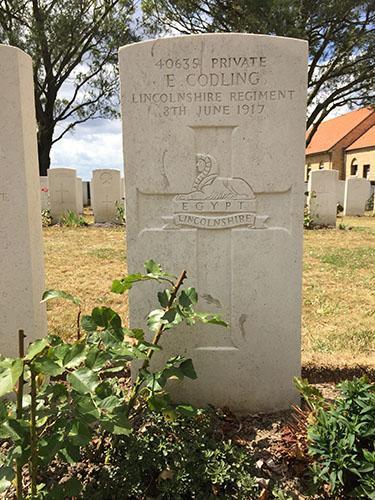
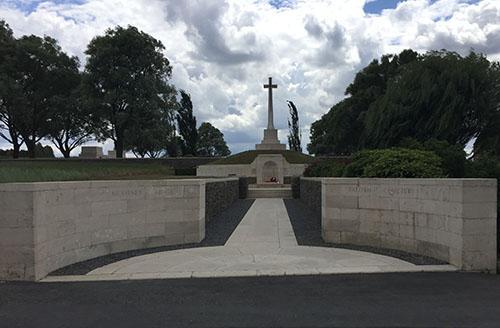
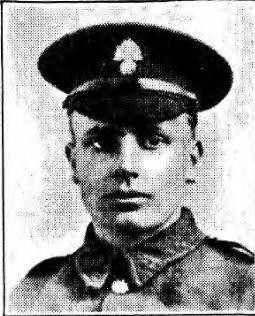
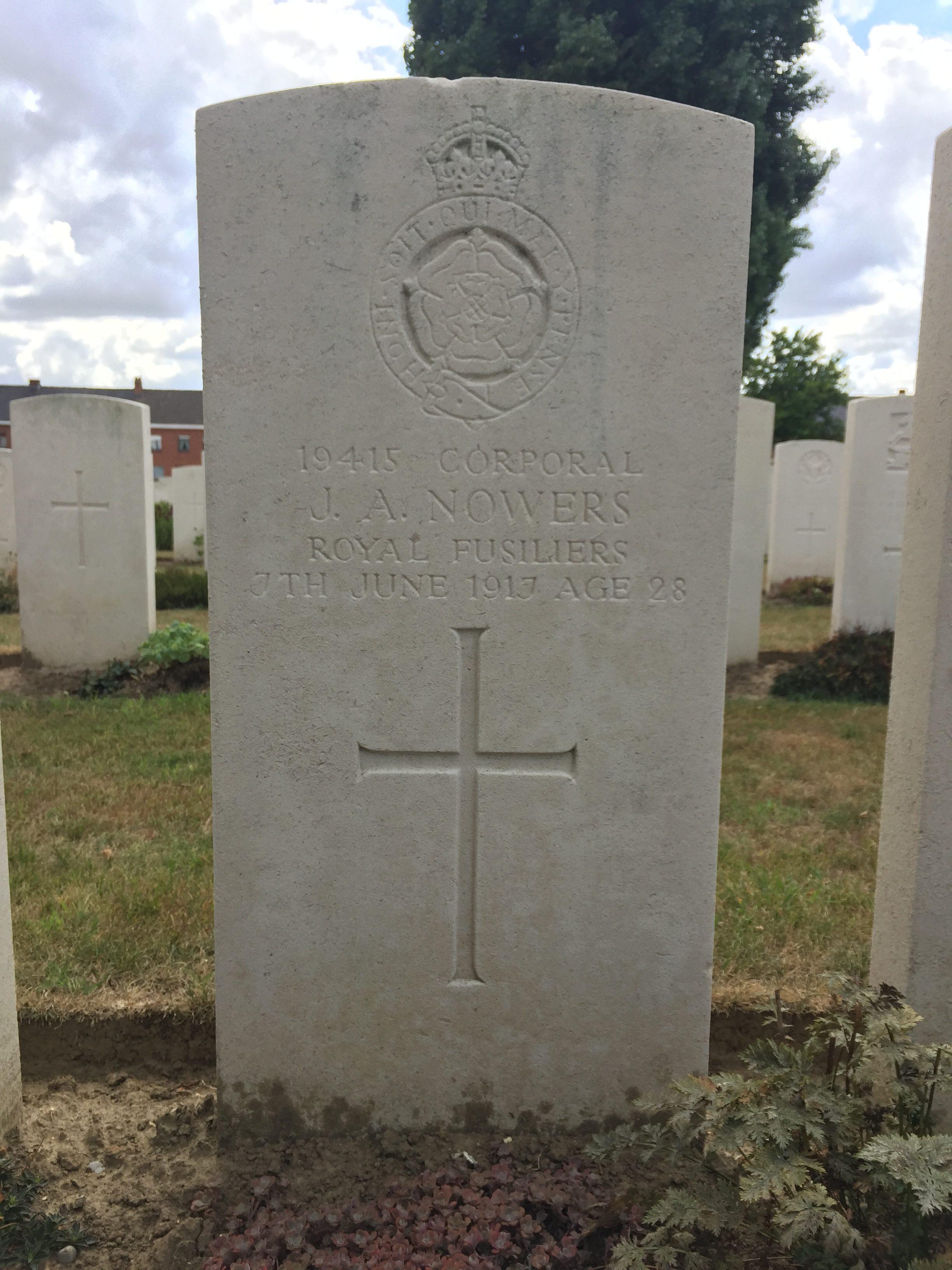
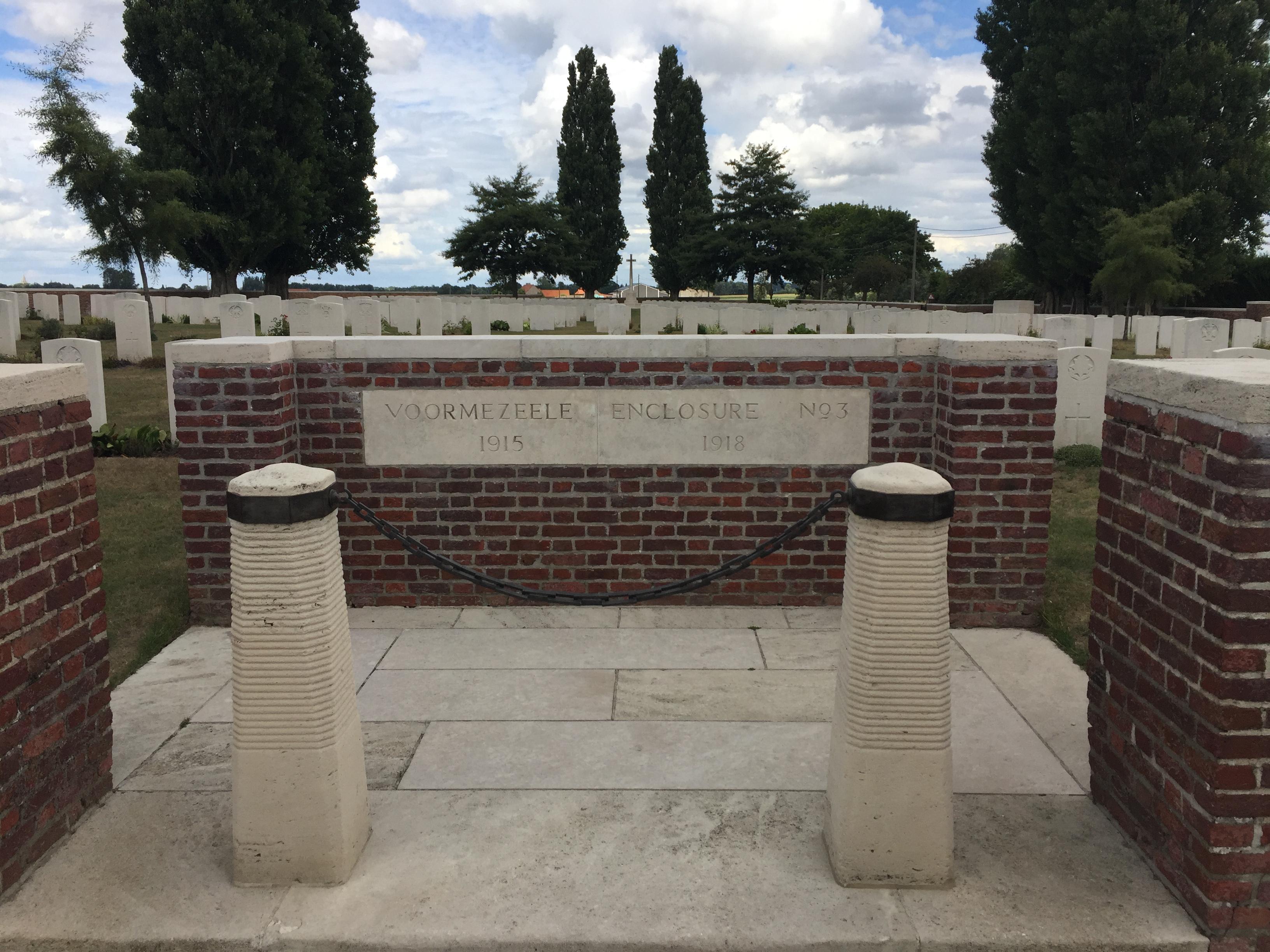
Recent Comments